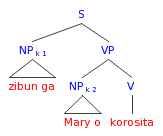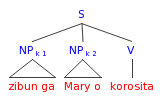- Michaeli loves himi
-
Principle B violation. The pronoun him
is bound in its binding domain by Michael,
which both C-commands it and
is coindexed with it.
- Hei loves Michaeli
-
Principle C violation. The R-expression
Michael is bound by him,
which both C-commands it and
is coindexed with it.
- Michael'sifather j loves himselfi
-
Principle A violation. The anaphor
himself is unbound.
Although Michael is coindexed
with himself, Michael
does not C-command himself.
- Michael'sifather j loves himj
-
Principle B violation. The pronoun him
is bound in its binding domain by Michael's father,
which both C-commands it and
is coindexed with it.
- Susani thinks that John
should marry herselfi
-
Principle A violation. Although the anaphor
herself is bound by Susan,
it is not bound within its
binding domain, i.e., within
the same clause.
- John thinks that Susan i
should kiss heri
-
Principle B violation. The pronoun her
is bound in its binding domain by Susan,
which both C-commands it and
is coindexed with it.
Problem 4
- John wai Mary ga k zibunk/*i hihansita to itta
In this example zibun is behaving like an anaphor on both readings. On the k reading it is bound in its binding domain by Mary. This is consistent with Principle A. If it were a pronoun this would be a Principle B violation. On the ungrammatical i reading it is bound by John, which is not in its binding domain. If we assume it is an anaphor the ungrammaticality is explained because we have a Principle A violation. If it were a pronoun this would be consistent with Principle B and the ungrammaticality would be unexplained.
- John wai zibun gai Mary o k korosita to omotteiru
In this example zibun is behaving like a pronoun on the given reading. On this reading, it is bound by John, which is not in its binding domain. If we assume it is an anaphor this would therefore be a Principle A violation. If on the other hand it is a pronoun this would be consistent with Principle B.
- * John wai zibun gak Mary ok korosita to omotteiru
This example is definitely a Principle C violation. It may also be either a Principle A or Principle B violation, depending on our assumptions about zibun and Japanese sentence structure.
If we assume zibun is an anaphor, and we assume that Japanese has a VP, as follows:

However if we assume no VP, then then the anaphor is bound and there is no Principle A violation:

On the other hand, if we assume that zibun is a pronoun, then if Japanese has a VP there is no Principle B violation, and if Japanese has no VP there is a principle B violation.
Whether we assume that zibun is a pronoun or an anaphor, and whether we assume a VP or not, this example must be a Principle C violation. According to the assumptions given, the R-expression Mary is C-commanded by something that binds it.
Problem 1
-
(i) Which pictures of himselfi does Johni despise?
To explain its grammaticality then, we must either change the Binding Theory or find a loophole. A possible loophole is to observe that
-
(ii) Johni despises which pictures of himselfi.
Problem 3
Persian
The Binding theory does not at first blush appear to account for the data.
In (a) and (b) xodesh appears to be inconsistent with being a pronoun, since it is bound in its binding domain on the k-indexing, and inconsistent with being an anaphor, since it is bound outside its binding domain on the i-indexing. It is inconsistent with being an R-expression on both readings, since it is bound on both readings.
The examples from formal speech (c) and (d) are consistent with the binding theory. xod is behaving like an anaphor, which can be bound only in its binding domain, its home clause.
A possible explanation for the misbehavior of (a) and (b) was supplied in class. -esh is a pronoun on its own. Therefore xodesh behaves both like a pronoun and an anaphor because it actually is an amalgam of the anaphor xod and the pronoun esh. The pronoun half is indexed on the i-indexing, the anaphor half on the k-indexing. Whoa.
Problem 6
Proposal: The definition of binding should be changed so that A binds B if and only if:
- A is coindexed with B
- A precedes B
We consider the following data with respect to this proposed revision of the Binding Theory:
-
(i) Although hei loves marshmallows, Arti is
not a big fan of Smores.
(ii) Hisiyearbook gives Tomi the creeps.
If the Binding Theory applies at D-structure, as proposed in problem 3, then there is a possible loophole for example (i), since it MIGHT involve movement. In that case, its D-structure source (the tree before movement applies) is plausibly:
-
Arti is
not a big fan of Smores, although hei loves marshmallows.
On the other hand, neither of these examples is problematic for our old definition of binding, which used C-command instead of precedence. In both cases the R-expression is unbound, because it is not C-commanded by the pronoun it coindexed with. Thus, on the C-command theory, there is no Principle C violation.